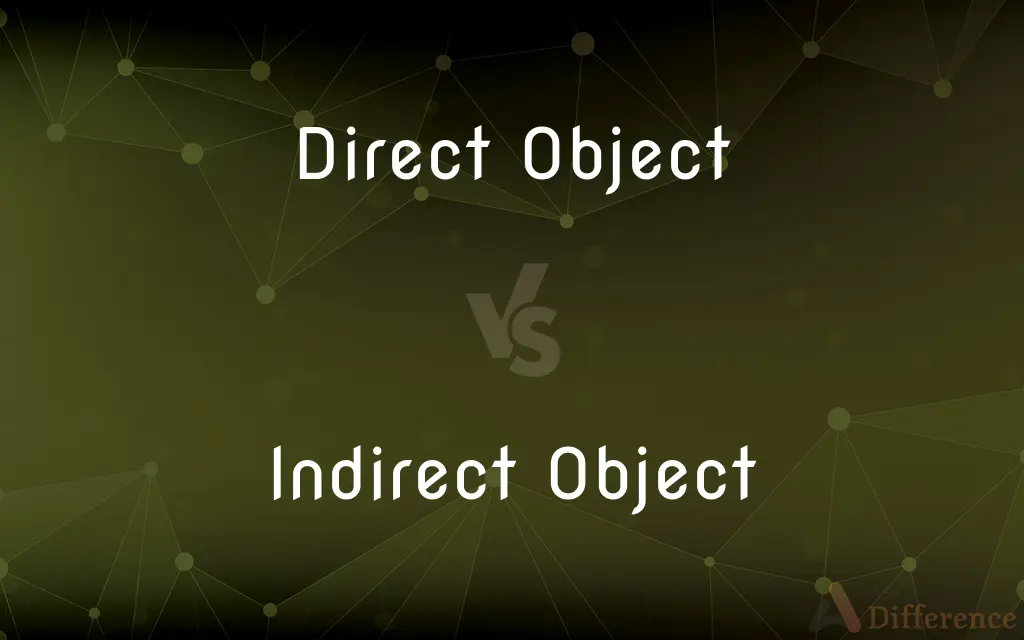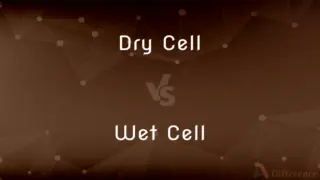Direct Object vs. Indirect Object — What's the Difference?
By Tayyaba Rehman — Published on January 1, 2024
A direct object directly receives the action of the verb, while an indirect object indirectly benefits from or is affected by the action.

Difference Between Direct Object and Indirect Object
Table of Contents
ADVERTISEMENT
Key Differences
In English grammar, the Direct Object is the noun or pronoun that receives the action of the verb directly. For example, in the sentence "She reads a book," the word "book" is the Direct Object because it's directly acted upon by the verb "reads." Conversely, the Indirect Object is the noun or pronoun that receives the Direct Object or benefits from the verb's action indirectly. In "She gave him a book," "him" is the Indirect Object because it's receiving the book (the Direct Object).
Both Direct and Indirect Objects are essential components in a sentence structure, often providing clarity and depth. The Direct Object is typically easy to identify as it immediately follows the verb and answers "what?" or "whom?" concerning the verb. The Indirect Object, however, answers "to whom?" or "for whom?" and is often found between the verb and the Direct Object. For instance, in "She tells her brother a story," "story" is the Direct Object and "her brother" is the Indirect Object.
Understanding the difference between Direct and Indirect Objects can significantly improve comprehension and communication. While the Direct Object is the primary receiver of the action, the Indirect Object is secondary but still pivotal. In sentences where both exist, the Direct Object can usually stand alone, but the Indirect Object typically needs the Direct Object to make complete sense.
The functions of Direct and Indirect Objects also differ. The Direct Object is crucial for completing the meaning of transitive verbs, while the Indirect Object adds nuance and context, often indicating the beneficiary of the action. For example, in "He sent her a letter," "letter" is the Direct Object, providing the core meaning, while "her" as the Indirect Object adds a layer of information about who benefits from the action.
In summary, while both Direct and Indirect Objects serve to convey more detailed information in a sentence, their roles differ significantly. The Direct Object is the primary recipient of the action, and the Indirect Object, though not always present, provides additional layers of meaning related to the beneficiary of the action.
ADVERTISEMENT
Comparison Chart
Definition
Receives the action of the verb directly.
Receives the action of the verb indirectly, usually the beneficiary.
Position in Sentence
Follows the verb directly.
Usually positioned between the verb and the Direct Object.
Answers the Question
"What?" or "Whom?" in relation to the verb.
"To whom?" or "For whom?" in relation to the action.
Dependence
Can stand alone without an Indirect Object.
Generally depends on a Direct Object to make sense.
Example
In "I read the book," "book" is the Direct Object.
In "I gave him the book," "him" is the Indirect Object.
Compare with Definitions
Direct Object
Receiver of the verb’s action.
She kicked the ball.
Indirect Object
Answers "to whom?" or "for whom?" after the verb.
He told her a story.
Direct Object
Central to the verb’s meaning in a sentence.
He wrote a letter.
Indirect Object
Indicates the beneficiary of the action.
They bought their mother a house.
Direct Object
Directly affected by the verb's action.
She broke the glass.
Indirect Object
Receives the Direct Object indirectly.
She gave him a gift.
Direct Object
Answers "what?" or "whom?" after the verb.
He painted a picture.
Indirect Object
Positioned between the verb and Direct Object.
She sent her friend an email.
Direct Object
Essential for completing transitive verbs.
They ate the cake.
Indirect Object
Adds nuance by indicating who benefits.
I baked my neighbor cookies.
Common Curiosities
How do you find a Direct Object in a sentence?
Identify the verb, then ask "what?" or "whom?" The answer is the Direct Object.
What is an Indirect Object?
An Indirect Object is a noun or pronoun that indirectly receives the action, often indicating the beneficiary.
Can an Indirect Object stand alone in a sentence?
No, an Indirect Object typically depends on a Direct Object for complete sense.
How do you identify an Indirect Object?
Look for a noun or pronoun between the verb and the Direct Object that answers "to whom?" or "for whom?"
Can a sentence have multiple Direct Objects?
Yes, some sentences can have two or more Direct Objects.
How do Direct and Indirect Objects affect sentence structure?
They add complexity and depth, providing more information about the action and its recipients.
Is an Indirect Object always necessary?
No, an Indirect Object is not always required for a sentence to make sense.
What is a Direct Object?
A Direct Object is a noun or pronoun that directly receives the action of a verb.
What happens if you remove the Direct Object?
Without a Direct Object, sentences with transitive verbs often become incomplete or lose meaning.
What types of verbs are associated with Direct Objects?
Transitive verbs are those that require a Direct Object.
Are Indirect Objects always people?
No, Indirect Objects can be people, animals, or even things, depending on the context.
Can a sentence have a Direct Object but no Indirect Object?
Yes, many sentences have a Direct Object without an Indirect Object.
Do Direct Objects always follow verbs directly?
Yes, Direct Objects usually follow verbs immediately.
Can prepositional phrases act as Indirect Objects?
No, Indirect Objects are typically nouns or pronouns, not prepositional phrases.
Can the order of Direct and Indirect Objects be changed?
Sometimes, especially with the use of prepositions, but the original meaning must remain clear.
Share Your Discovery

Previous Comparison
Dry Cell vs. Wet Cell
Next Comparison
Net Investment vs. Gross InvestmentAuthor Spotlight
Written by
Tayyaba RehmanTayyaba Rehman is a distinguished writer, currently serving as a primary contributor to askdifference.com. As a researcher in semantics and etymology, Tayyaba's passion for the complexity of languages and their distinctions has found a perfect home on the platform. Tayyaba delves into the intricacies of language, distinguishing between commonly confused words and phrases, thereby providing clarity for readers worldwide.
















































